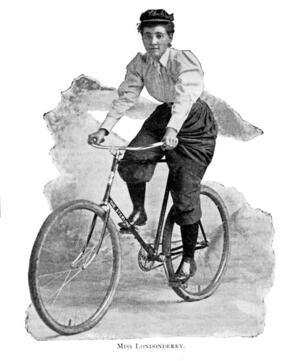First woman to cycle the globe begins journey
Annie Cohen Kopchovsky, known as Annie Londonderry, in the final incarnation of her bicycle riding costume. She was the first woman to ride a bicycle around the world in 1894-1895. Source: Annie Londonderry--the first woman to bicycle around the world, by Peter Zheutlin. © Peter Zheutlin.
Her adventure began with a bet. In 1894, a gentleman in Boston bet another gentleman, $20,000 against $10,000, that no woman could travel around the world by bicycle, a feat that had been completed for the first time by a man in 1885. Although it is not clear why she was chosen, Annie Cohen Kopchovsky set out from Boston on June 25, 1894, to attempt the journey. Married and a mother of three children under age six, she was an unlikely choice but a good example of the ways that the bicycle was transforming women's lives. Besides providing women with a respectable form of independent transportation, the popularity of the bicycle led to changes in women's dress, for example, as bloomers replaced unwieldy and inconvenient full skirts.
Under the terms of the bet, Kopchovsky, who had ridden a bicycle for the first time only days before her departure from Boston, was supposed to begin her journey penniless, earn $5,000 above her expenses along the way, and finish her trip in fifteen months. Her resourcefulness was in evidence from the first day. On her way out of Boston, she hung a placard advertising Londonderry Lithia Spring Water Company from her bicycle, and accepted $100 from the company's representative in return. In addition, she agreed to be known as Annie Londonderry.
Kopchovsky, alias Londonderry, reached Chicago in September, and there she nearly gave up the trip altogether. Ultimately, however, she traded in her 42-pound ladies' bicycle for a men's model that weighed half as much, and set out again in the opposite direction, headed back east. She sailed from New York for France in November. In France, Kopchovsky earned money by carrying advertising on her clothing and her bicycle as she rode the main streets of Marseilles and other cities. Later in her trip, she would give lectures in which she embellished her story with lurid details of accidents, near-death experiences, and dangers narrowly averted.
Because the terms of the bet did not specify how many miles she had to ride, Kopchovsky sailed from Marseilles all the way to East Asia, with brief stops in Egypt, Sri Lanka, and Singapore. After a tour through China, she was in Japan by March. On March 23, she arrived back in the United States through San Francisco Bay's Golden Gate. Over the next six months, she bicycled across the southwest, great plains, and midwest, reaching Chicago on September 12, 1895, just under fifteen months from her original departure from Boston, and only ten months after her re-departure from Chicago.
She had done what the Boston gentleman had bet $20,000 no woman could do. Not only had she circumnavigated the globe by bicycle, an astounding athletic feat in itself, but she had done it alone, proving that a woman could make her own way in what was still very much a man's world. Bucking the entrenched gender norms of her day, she had fended for herself and survived physical injury, mechanical problems with her bicycle, and the scrutiny of the press. In Chicago, Kopchovsky collected her $10,000 prize and then rejoined her family. After a move to New York, she wrote sensational features for the New York World for a time, including an account of her trip. She seems to have then retreated to family life, raising her three children and largely disappearing from the historical record. She died in 1947.
Sources: Peter Zheutlin, "Chasing Annie," Bicycling, May 2005; www.annielondonderry.com/.




I am in agreeance with my husband I very much enjoy her story.
👉👈
Very helpful😁